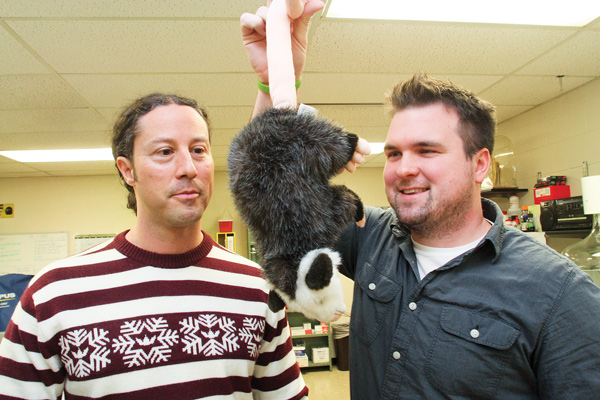Tales of tails


YSU professor Michael Butcher, left, and graduate student Joe Rupert are researching Costa Rican opossums and their tails, which serve as a long, hairless fifth appendage.
Student studies opossums to better understand muscle disorders
YOUNGSTOWN
OPOSSUMS ARE A COMMON sight in Ohio, but most people don’t give the marsupials a second glance.
That’s not the case for one Youngstown State University graduate student who has spent the last two years studying the animal and its tail.
Joe Rupert of Columbiana is studying biomechanics and preparing a research paper about the tails, which serve as a long, hairless fifth appendage. His research centers on the difference in tails between North American opossums that live on land and Central and South American opossums that live in the trees.
“Terrestrial opossums use their tail to pick up offspring, using it to make something like a seat belt on their backs, and gather sticks and leaves for their nesting site,” Rupert said.
Arboreal opossums use their tails to suspend from trees and balance as they move from branch to branch, he said.
The tail of a land opossum is about 3.5 inches, compared with the tree opossum’s 17.5-inch tail.
Rupert’s work looks at the development of tail muscles, and, as he hypothesized, the terrestrial opossum tails have more of a “slow twitch” for endurance and the arboreal opossum tails have a “fast twitch” of explosive power for a short amount of time.
But the research goes deeper, examining the development of muscle tissue over time.
An opossum reaches adult age at seven months. By studying the land opossum, Rupert found that at seven months the tail went from having a fast twitch like its arboreal relatives to a slow twitch.
“There’s a key protein that changes,” Rupert said.
The information is valuable because it can be used to better understand muscular disorders in people, said Dr. Michael T. Butcher, assistant professor of biological sciences at YSU and Rupert’s adviser.
Butcher guided Rupert’s research, which included muscle-tissue biopsies from opossums conducted in the manner similar to how people get biopsies on moles.
“We need fresh tissue to do this research accurately,” Butcher said.
All opossums used in observational and hands-on research, whether in Ohio or Costa Rica, were returned to their habitats, he added.
Rupert, who earned his undergraduate degree in biology at YSU, said he plans to continue his research.
“I was on my way to [medical] school and was intercepted by [Butcher]. I got into research and am interested in it because I have free control over any question. There’s never a dull moment,” he said.
 43
43
